
Vazirani Akinosi Mandibular Nerve Block also called as VA Block is a mandibular nerve block which is preferred in patients with limited mouth opening as it is a closed mouth nerve block. It can be very useful in patients with large tongue or buccal fat which make it difficult to administer a Gow Gates or Inferior Alveolar Nerve Block effectively. It is also very useful in patients having limited mouth opening. Another advantage of this Technique is lack of obstructions in the path of entry of the needle, as there are no muscles or other structures as seen with IA or Gow Gates technique. According to clinical trials V-A block was found to be more acceptable by the patient as compared to other blocks.
It was first introduced by Dr. Joseph Akinosi is 1977 as a Closed mouth alternative to Gow Gates technique.
It is also called as Tuberosity Block or Closed mouth Mandibular Nerve Block. Another advantage of this block is that it anesthetizes the Mylohyoid nerve as well which is one the major reasons for IAN block being less effective in some cases.
With the Vazirani Akinosi Nerve Block the branches of the Mandibular Nerve anesthetized are –
- Inferior Alveolar Nerve
- Lingual Nerve
- Mental nerve
- Incisive nerve
- Mylohyoid Nerve
It is not called a True Mandibular nerve Block as it does not anesthetize the entire Mandibular Nerve and its branches.
Structures Anesthetized by Vazirani Akinosi Nerve Block:
- Mandibular Teeth up to the midline
- Gingiva and Periodontium of the Lingual side
- Buccal Gingiva and Periodontium of the Anterior and Premolars
- Sometimes Buccal Gingiva and Periodontium of the Posterior Molars
As Mylohyoid Nerve is also anesthetized with this Nerve Block, it is known to have higher effectiveness in comparison to IAN block which fails to anesthetize the first molar completely in some cases.
Contraindications of Vazirani Akinosi Nerve Block:
- Patients with Acute Infection in the Pterygomandibular space
- Patients with Acute Infection in the Maxillary Tuberosity region
Injection site and Technique of Vazirani Akinosi Nerve Block:
The target site for the injection of the VA block where the anesthetic solution needs to be deposited is the Medial surface of the mandibular ramus within the pterygomandibular space adjacent to the maxillary tuberosity halfway between the mandibular foramen and the neck of the condyle.

Landmarks of VA Nerve Block – Medial surface of the mandibular ramus, Mucogingival junction of the maxillary second or third molars.
Technique – Apply topical anesthesia gel on the soft tissue just behind the maxillary tuberosity near the mucogingival junction of the 2nd or 3rd molars. Here on palpation you should be feeling tissue between the maxillary tuberosity and medial portion of the mandible.

- Ask the patient to gently close or clench their teeth while relaxing their muscles, as stiff muscles will prevent the anesthetic solution from being deposited into the Pterygomandibular space as it will be obliterated by the muscles of mastication. (Patient can also be asked to slightly open the mouth without clenching).
- Retract the cheek and buccal fat laterally away from the teeth using a mouth mirror or Minnesota retractor which ever you feel comfortable.
- Palpate or Feel the coronoid process and rest your finger on the coronoid process.
- Now identify the Point of insertion which is in posterior tissue visible.
- The height of insertion of needle is determined by the Mucogingival junction of the Maxillary gingiva, the needle has to be inserted parallel to the mucogingival junction and moved posteriorly touching the soft tissue.
- The medial border should be the Maxillary tuberosity while the Lateral border should be the Tendona Temporalis – The insertion point will be in between the two borders.
- Some doctors suggest to bend the needle slightly while some do not prefer this approach. If you want to bend the needle – loosed the cap of the Syringe slightly after loading the syringe and bend the needle very slightly.
- Now ask the patient to bite down their teeth and insert the needle parallel to the mucogingival junction into the posterior mucosa with the bend of the needle towards the lateral cheek. The bevel of the needle should be oriented away from the mandibular ramus bone facing the midline.
- After inserting the needle correct the angle making it parallel to the maxillary occlusal plane. No Hard tissue should be touched and if you have touched bone it can be the coronoid process which should be corrected by redrawing the needle and inserting it around the obstruction.
- The depth of the needle should be approximately 25mm or 2/3rd to 3/4th of a long needle measured from the maxillary tuberosity.
- It should be a painless procedure and if pain is felt it mostly likely will be because of penetration of the Temporalis (laterally) or Medial pterygoid (medially).
- The injection site of Vazirani Akinosi Nerve block is superior to the IAN block and inferior to the Gow Gates Nerve block.
- Deposit the Solution in the Pterygomandibular space, this helps in bringing the inferior alveolar nerve and the lingual nerve in contact with the Anesthetic Solution.
Possible Complications of VA Nerve Block:
Accidental Anesthetic deposition of LA agent into the Parotid Gland which is posterior to the Ramus which anesthetizes the Facial nerve travelling through the Gland. This leads to Transient Hemifacial Paralysis which is a reversible complication.
Owning to all the advantages it has over the IAN block, this can be used in patients who have a history of failed IA nerve blocks due to accessory nerve innervations or anatomic variations in the Nerves.


